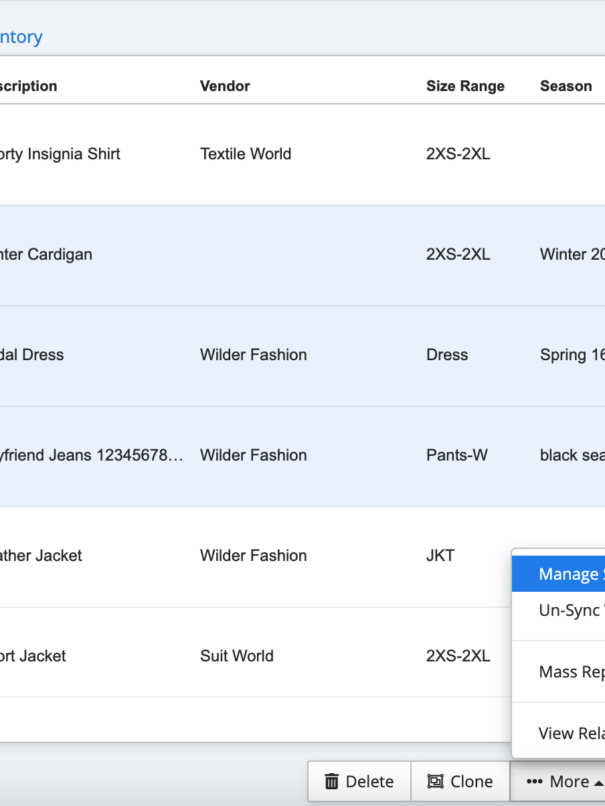Acquiring a new enterprise resource planning system can be a step towards modernization and improvement for any business, but it’s a decision that requires careful thought and planning.
Our guide will walk you through the essential points to consider to help you make a well-informed choice that aligns with your business goals and current capabilities.
Let’s dive into the factors that should shape your ERP selection process.
Understanding Business Needs and The Aspect of Higher Ups and Key Stakeholders
First and foremost, you need to understand why you’re looking for a new ERP system. Is your current system outdated, or are you looking to streamline and integrate various business processes under one roof? This will help you tremendously in your ERP selection process.
Consider this: Imagine you’re running an apparel business in multiple locations. Every day orders, inventory, payroll, and customer data are managed separately at each site. This fragmented approach not only creates inefficiencies but also increases the risk of errors. An ERP system could unify all these processes, offering real-time insights into inventory levels across locations, automating payroll, and providing a single view of customer data. In essence, it could simplify your operations and save you countless hours each week.
To clearly define your needs, engage with key stakeholders across your organization. Ask them what their pain points are and what features they believe would make their work more efficient. This collaborative approach not only helps in identifying the right system but also fosters a sense of ownership among your team, which is crucial for successful implementation.
Evaluating Technical Requirements and The Aspect of IT Team and Technical Managers
Once you have a clear understanding of your business needs, it’s time to look at the technical aspects. The choice between a cloud-based or on-premises ERP system is one of the first technical decisions you’ll face.
Cloud-based ERP systems are known for their flexibility and lower upfront costs. They are hosted on the vendor’s servers and accessed via the Internet, making them a great option for businesses that want to avoid the hassle of maintaining their own IT infrastructure. Moreover, these systems are scalable, meaning they can grow with your business, adding more users or modules as needed without significant additional investment. They can also be accessed via mobile which only improves convenience.
On the other hand, on-premises ERP systems are installed on your company’s own servers. While they often come with higher initial costs due to the need for hardware and in-house IT management, they can be customized to a greater extent and may offer better control over data and security.
In addition to choosing between cloud and on-premises options, consider the system’s integration capabilities. Your new ERP must be able to work seamlessly with existing applications and tools your business relies on, such as CRM systems, financial software, or industry-specific applications. This ensures smooth data flow and minimizes disruptions during the transition.
Cost Considerations and The Aspect of Financial Managers and Budget Holders
Acquiring an ERP system is a significant investment, and it’s essential to understand the total cost of ownership. This includes not just the initial purchase price, but also ongoing costs such as maintenance, support, and potential upgrades.
Initial costs can vary widely depending on the system and the scope of the implementation. For example, a cloud-based ERP might involve a subscription fee based on the number of users and the modules you choose. In contrast, an on-premises system typically requires a substantial upfront investment in both software and hardware.
Ongoing costs are another critical factor. These can include regular maintenance and support fees, which are necessary to keep the system running smoothly and up-to-date. For cloud-based systems, these costs are often rolled into the subscription fee, while on-premises systems may require periodic investments in IT resources and infrastructure updates.
It’s also wise to consider potential future expenses. As your business grows, you might need additional licenses or modules, or you may decide to customize the system further to better meet your needs. All these factors should be part of your financial planning when evaluating an ERP solution.
User Experience and Adoption and the Aspect of End-Users and Department Managers
An ERP system is only as good as its users. No matter how feature-rich or technically advanced a system is, if your team finds it cumbersome or difficult to use, it won’t deliver the expected benefits. Therefore, user experience and ease of use should be top considerations in your decision-making process.
Look for systems that offer intuitive interfaces and easy navigation. These kinds of systems help reduce the learning curve for new users. This is particularly important if your team is not particularly tech-savvy or if you’re implementing the system across multiple departments with varying levels of technical expertise.
Training and support are also critical components of user adoption. Make sure that the ERP vendor provides comprehensive training resources and responsive support services. This will not only help your team get up to speed quickly but also ensure they have the assistance they need to overcome any challenges they encounter.

ERP Implementation and Change Management and The Aspect of Staff
Implementing a new ERP system is a major project that can significantly impact your organization’s day-to-day operations. Effective change management is crucial to ensure a smooth transition and to minimize disruptions.
Start by developing a detailed implementation plan that outlines the steps and timelines for the rollout. This should include everything from initial data migration and system setup to user training and final go-live. Involve all relevant stakeholders in the planning process to ensure their needs and concerns are addressed.
Change management also involves preparing your team for the transition. This can be challenging, especially if the new system represents a significant departure from existing processes. Communicate clearly and frequently about what to expect during the implementation and how the new system will benefit them in their roles.
Phased implementation can be an effective strategy to manage change. Instead of rolling out the entire system at once, consider implementing it in stages, focusing on one module or department at a time. This approach allows for adjustments based on initial feedback and helps mitigate risks associated with large-scale changes.
When selecting an ERP system, the choice of vendor is crucial. If you’re considering ApparelMagic, understanding what they offer and how they align with your needs is essential. Here’s a streamlined look at what ApparelMagic provides and how it fits into your selection criteria.
ApparelMagic: Tailored Solutions for the Fashion Industry
ApparelMagic is one of the most popular fashion ERP vendors dedicated to the streamlining of apparel business operations providing comprehensive features to manage and streamline these operations effectively. Here’s what makes ApparelMagic a strong contender you should consider during your ERP selection process.
Key Features
- Industry-Specific Functionality: ApparelMagic excels with modules tailored for fashion businesses, including inventory management, order processing, and product lifecycle management. It handles the complexities of size and color variations and seasonal collections effortlessly.
- Integrated E-commerce and Wholesale Management: It offers robust integration capabilities with e-commerce platforms like Shopify, allowing seamless synchronization across multiple sales channels. This integration simplifies management and improves efficiency.
- Comprehensive Inventory Control: With sophisticated inventory management, ApparelMagic provides real-time visibility into stock levels, helping you manage inventory across various locations efficiently. This feature is particularly beneficial for businesses dealing with fast-moving inventory and seasonal changes.
- Flexible Reporting and Analytics: ApparelMagic’s reporting and analytics tools can be customized to meet your specific needs, enabling you to track key performance indicators and make data-driven decisions.
- Scalability and Customization: As your business grows, ApparelMagic can scale with you. Its modular approach allows for the addition of new features, integrations, and capabilities, ensuring the system evolves with your business.
Wrap Up on the Aspects You Need to Consider for Your ERP Software Selection Process
The ERP selection process is a critical step toward modernizing and optimizing your business operations. It requires balancing various factors—understanding your business needs, evaluating technical requirements, considering financial implications, and ensuring user adoption.
Involving stakeholders, engaging with your IT team, and planning for future growth are essential elements that guide you to the right choice. For businesses in the fashion industry, ERP solutions like ApparelMagic provide industry-specific features that streamline operations and offer flexibility as your business evolves.
By approaching your ERP selection with careful consideration of these factors, you can choose a system that aligns with your goals and supports your long-term success. Remember, the right ERP will not only meet your current needs but also scale with your business, enhancing efficiency and driving growth.







